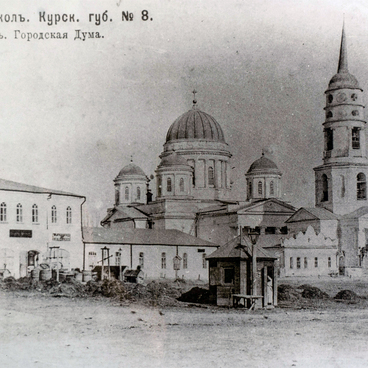The portrait of an unknown woman entered the collection of the museum in the 1960s. The title “Portrait of a Petty Bourgeois Woman” stuck to the painting, as the clothing of the portrayed woman corresponds to the urban costume of this estate of the last quarter of the 19th century.
The female population of Stary Oskol included representatives of different estates: noblewomen, petty bourgeois, representatives of the industrial bourgeois and merchant class, wives of craftsmen and raznochintsy. Parochka dresses, blouses with puffed sleeves, and wide skirts were in fashion in Russia at that time. Festive clothes were decorated with frills, lace, bows and ruffles. Intricate hats complemented the costumes. Educated urban women wore dark skirts and blouses of lighter colors. In the early 20th century, skirts and blouses were more popular than dresses. Dressmakers sewed blouses from muslin, silk, satin, and decorated them with lace and braid. It is worth noting that in that period, because of the opulent decor of the dress or ensemble, few ornaments were worn.
According to local historians, there was a grocery store in town where local artists displayed their paintings. At this peculiar urban exhibition, artists could both show and sell their work. This portrait is presumably a work of an artist from Stary Oskol. The middle-aged woman wears a dark dress with a white collar and a lace mob cap on her head. A mob cap was a headdress that women wore at home, but it looks exquisite and smart on the sitter. The pale face and headpiece contrast with the dark neutral background.
The portrait, painted in oil on canvas, was later cut out in the shape of an oval and glued to another canvas pulled on a stretcher; on top it is covered by a rectangular two-layer cardboard with a granular black coating; in the corners is a stuccowork light-brown floral ornament. In the center of the frame is a carved oval, with its edge covered in bronze paint. The portrait dates from the last quarter of the 19th century, at which time woodcarving was the most common technique used to make frames. The surface of the frame was then covered with paint, varnish, gold, metal, and papier-mâché. The peculiarity of this picture is that it is mounted without a frame. The mount itself is also unusual — it has an inset edge that separates the painting from the mount.
The female population of Stary Oskol included representatives of different estates: noblewomen, petty bourgeois, representatives of the industrial bourgeois and merchant class, wives of craftsmen and raznochintsy. Parochka dresses, blouses with puffed sleeves, and wide skirts were in fashion in Russia at that time. Festive clothes were decorated with frills, lace, bows and ruffles. Intricate hats complemented the costumes. Educated urban women wore dark skirts and blouses of lighter colors. In the early 20th century, skirts and blouses were more popular than dresses. Dressmakers sewed blouses from muslin, silk, satin, and decorated them with lace and braid. It is worth noting that in that period, because of the opulent decor of the dress or ensemble, few ornaments were worn.
According to local historians, there was a grocery store in town where local artists displayed their paintings. At this peculiar urban exhibition, artists could both show and sell their work. This portrait is presumably a work of an artist from Stary Oskol. The middle-aged woman wears a dark dress with a white collar and a lace mob cap on her head. A mob cap was a headdress that women wore at home, but it looks exquisite and smart on the sitter. The pale face and headpiece contrast with the dark neutral background.
The portrait, painted in oil on canvas, was later cut out in the shape of an oval and glued to another canvas pulled on a stretcher; on top it is covered by a rectangular two-layer cardboard with a granular black coating; in the corners is a stuccowork light-brown floral ornament. In the center of the frame is a carved oval, with its edge covered in bronze paint. The portrait dates from the last quarter of the 19th century, at which time woodcarving was the most common technique used to make frames. The surface of the frame was then covered with paint, varnish, gold, metal, and papier-mâché. The peculiarity of this picture is that it is mounted without a frame. The mount itself is also unusual — it has an inset edge that separates the painting from the mount.


